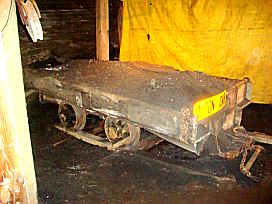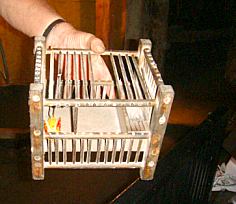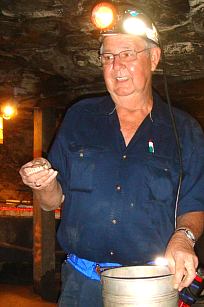Beckley Exhibition Coal
Mine
513 Ewart Ave
Beckley, WV 25802
May 10th, 2008
Have you ever been down in a coal mine? A real coal mine. Well I had not,
so when a opportunity arrived to visit such a dark and damp place I jumped at
the chance. We had been traveling from Virginia to a summer haunt in Ohio
and had stopped in Beckley for a night which became a week. The Beckley Exhibition
campground is just a small part of the conglomerate made up of the mine, the Mountain
Homestead Museum, and the Youth Education center. Having made our
introductions at the office, we acquired our tickets to ride and headed down to
the old electric car barn where we
you ever been down in a coal mine? A real coal mine. Well I had not,
so when a opportunity arrived to visit such a dark and damp place I jumped at
the chance. We had been traveling from Virginia to a summer haunt in Ohio
and had stopped in Beckley for a night which became a week. The Beckley Exhibition
campground is just a small part of the conglomerate made up of the mine, the Mountain
Homestead Museum, and the Youth Education center. Having made our
introductions at the office, we acquired our tickets to ride and headed down to
the old electric car barn where we  would
start our tour. Here we met Cliff Chandler, a 70 something year old miner
who had spent some 40 years in the mines and would be our tour guide and train
operator. Cliff explained that most of the things he was going to talk
about were down in the mine so we talked about general items. I learned
that the mine once produced a good grade of coal but the vein finally became too
small to be worthwhile and in 1910 it closed. It lay dormant until
1962 when it opened up as a museum. The little train cars we would be
riding in would be pulled by an electric engine he called a coal puller, or
gathering motor built sometime around 1930. It was slow but very powerful.
He estimated that the tracks we would be using today were laid out in about a
200 foot long circle
would
start our tour. Here we met Cliff Chandler, a 70 something year old miner
who had spent some 40 years in the mines and would be our tour guide and train
operator. Cliff explained that most of the things he was going to talk
about were down in the mine so we talked about general items. I learned
that the mine once produced a good grade of coal but the vein finally became too
small to be worthwhile and in 1910 it closed. It lay dormant until
1962 when it opened up as a museum. The little train cars we would be
riding in would be pulled by an electric engine he called a coal puller, or
gathering motor built sometime around 1930. It was slow but very powerful.
He estimated that the tracks we would be using today were laid out in about a
200 foot long circle  which
looped back into itself near the entrances. After a short wait for the
other passengers, we boarded the cars and were soon creeping down the
mine. We had not left the light of the entrance when the temperature
dropped and the humidity jumped up. Cold and damp is a reality of the
mine. Water dripped from the ceiling in most places. On we
crept
into the darkness until the only light was from a single small light bulb
suspended from a lone power line strung across the ceiling near the walls.
The passage was short and narrow, narrow to the point of almost
hitting the walls with the carts. When we did stop and were allowed to get
out and look about, there usually
was not enough headroom to stand up. Our first stop was at a widened part of
the mine where there were several items that Cliff talked about. In his
soft West Virginia accent, he explained that the end of the 1800s was not a good time to
which
looped back into itself near the entrances. After a short wait for the
other passengers, we boarded the cars and were soon creeping down the
mine. We had not left the light of the entrance when the temperature
dropped and the humidity jumped up. Cold and damp is a reality of the
mine. Water dripped from the ceiling in most places. On we
crept
into the darkness until the only light was from a single small light bulb
suspended from a lone power line strung across the ceiling near the walls.
The passage was short and narrow, narrow to the point of almost
hitting the walls with the carts. When we did stop and were allowed to get
out and look about, there usually
was not enough headroom to stand up. Our first stop was at a widened part of
the mine where there were several items that Cliff talked about. In his
soft West Virginia accent, he explained that the end of the 1800s was not a good time to
 work in a mine.
Because the only tools used were picks, shovels and dynamite, mines were never
expanded beyond the coal vein. The vein in this mine was only about 3 feet
high which meant that the miners spent their entire workday on their
knees. The dynamite would break up the vein, then the miners would pick it
free and shovel it into either one or two ton coal cars. Working steadily
with only a few breaks, a miner could fill as many as 10 one ton cars. For
this he would be paid about 20 cents per car. Giving
him, hopefully, $2.00 a day for his effort. But there were expenses to this
job. The miner had to pay for rent of the company owned cottage that he
lived in. The coal he used in his small heating stove was not free, nor
was his food. In the mine, he was responsible for most of the expense of
getting the coal out, including the dynamite, as well as the timbers he used to shore up the ceiling
around him. At the end of the day, there just wasn't that much left, but
of course the mine owners had the answer for that. Highly elevated priced
goods at the company store. A miner could borrow mine scrip, often in coin
form which could be spent at the company operated
work in a mine.
Because the only tools used were picks, shovels and dynamite, mines were never
expanded beyond the coal vein. The vein in this mine was only about 3 feet
high which meant that the miners spent their entire workday on their
knees. The dynamite would break up the vein, then the miners would pick it
free and shovel it into either one or two ton coal cars. Working steadily
with only a few breaks, a miner could fill as many as 10 one ton cars. For
this he would be paid about 20 cents per car. Giving
him, hopefully, $2.00 a day for his effort. But there were expenses to this
job. The miner had to pay for rent of the company owned cottage that he
lived in. The coal he used in his small heating stove was not free, nor
was his food. In the mine, he was responsible for most of the expense of
getting the coal out, including the dynamite, as well as the timbers he used to shore up the ceiling
around him. At the end of the day, there just wasn't that much left, but
of course the mine owners had the answer for that. Highly elevated priced
goods at the company store. A miner could borrow mine scrip, often in coin
form which could be spent at the company operated store only and then would be
taken out of his pay at the end of the two week pay period. Some miners
with families often spent more in script then they made in the mines, giving
rise to the words of a famous Tennessee Ernie Ford song "I owe my soul to
the company store". The single weak light bulb which created great
shadows with its soft glow, as we listen, didn't exist when this mine was in its heyday.
Instead, miners used an even weaker light made by a single candle-like flame
from a carbide lantern on his
store only and then would be
taken out of his pay at the end of the two week pay period. Some miners
with families often spent more in script then they made in the mines, giving
rise to the words of a famous Tennessee Ernie Ford song "I owe my soul to
the company store". The single weak light bulb which created great
shadows with its soft glow, as we listen, didn't exist when this mine was in its heyday.
Instead, miners used an even weaker light made by a single candle-like flame
from a carbide lantern on his  helmet. Water was added to a carbide block
which created the gas needed for the flame. A small striker wheel just
like an old cigarette lighter mounted below the flame nozzle was used to ignite
the flame. One of the major problems with this was that coal mines are notorious
for creating methane gas pockets. Explosions were a far greater danger back
then, then they are today. To remedy this, the mines created one of the most
unpopular jobs there was. Some poor miner got to take his carbide lantern
and climb up in each crack and crevice to burn off the pockets of gas before
they got so big they would explode, he hoped. Many a miner's last day on
the job was finding a pocket that had grown larger then the small bright
flashover he had hoped to cause. Still, pockets of the deadly gas could
slip by undetected. For those who could afford it, a miner might have a small
cage containing a canary. As long as the bird sang, the miner would
work. When the bird quit chirping, it was time to leave, and most likely
buy another bird.
helmet. Water was added to a carbide block
which created the gas needed for the flame. A small striker wheel just
like an old cigarette lighter mounted below the flame nozzle was used to ignite
the flame. One of the major problems with this was that coal mines are notorious
for creating methane gas pockets. Explosions were a far greater danger back
then, then they are today. To remedy this, the mines created one of the most
unpopular jobs there was. Some poor miner got to take his carbide lantern
and climb up in each crack and crevice to burn off the pockets of gas before
they got so big they would explode, he hoped. Many a miner's last day on
the job was finding a pocket that had grown larger then the small bright
flashover he had hoped to cause. Still, pockets of the deadly gas could
slip by undetected. For those who could afford it, a miner might have a small
cage containing a canary. As long as the bird sang, the miner would
work. When the bird quit chirping, it was time to leave, and most likely
buy another bird.
On down we traveled in our slow moving train which shook
and wobbled at every turn, until we arrived at other destinations with other
stories. At one particular stop we learned
about the lunch bucket. In the days of this mine there was no cafeteria
topside that the miners could go to during their hour lunch break. There were no
lunch breaks. Miners ate whatever they brought with them on the job, on
their own time, and time was money. The lunch pail was pretty universal, aluminum,
round and with a second bucket taking up half of the inside. The pail was filled half full of water
and then the top pail was placed over the water. The second pail contained the
food. With any luck the miner would find a "widow maker" nearby to sit
on while he ate, like the one the pail is sitting on
in the picture. A widow maker was created eons ago when trees stumps
protruding down to where the mine would be, were petrified, then millions of
years later, cut off when the mine was dug, leaving the stump's upper
portion embedded in the ceiling. Although the stump itself was now a hard stone
often weighing hundreds of pounds, the bark which had been around it, had
turned to coal rather then stone. As work continued in the mine, the coal around
the stump would loosen and the stone stump would come crashing down to the mine
floor, with often fatal results if a miner was walking by at that precise
moment. In any case, another miner's dining seat was created. The
miners had only the water they brought, so if a miner ran out, well, all miner's
pails looked alike. To prevent water loss from such "mistakes", miners would
often leave a set of false teeth in the water to prevent others from taking more
than they had brought for themselves. Cliff was a treasure trove of trivia-like facts about the life in the mines. One of the more common creatures
to be found deep in a mine were rats. I would have thought that with such
a sparse environment that such animals could not have survived long. They
owed their survival to the miners. No meal was complete until a little
food had been left for the rats. What might sound like a far-fetched tale
or at best some superstition, was actually rooted in decades of experience and
observation. As Cliff explained, years of mining had taught the miners
that rats have a sixth sense about survival. The lesson taught by these
small creatures was that "If you see the rats running by you in number, run
the same way! You are probably minutes if not seconds from
disaster." Many an early century miner owed his life to this
knowledge.
which had been around it, had
turned to coal rather then stone. As work continued in the mine, the coal around
the stump would loosen and the stone stump would come crashing down to the mine
floor, with often fatal results if a miner was walking by at that precise
moment. In any case, another miner's dining seat was created. The
miners had only the water they brought, so if a miner ran out, well, all miner's
pails looked alike. To prevent water loss from such "mistakes", miners would
often leave a set of false teeth in the water to prevent others from taking more
than they had brought for themselves. Cliff was a treasure trove of trivia-like facts about the life in the mines. One of the more common creatures
to be found deep in a mine were rats. I would have thought that with such
a sparse environment that such animals could not have survived long. They
owed their survival to the miners. No meal was complete until a little
food had been left for the rats. What might sound like a far-fetched tale
or at best some superstition, was actually rooted in decades of experience and
observation. As Cliff explained, years of mining had taught the miners
that rats have a sixth sense about survival. The lesson taught by these
small creatures was that "If you see the rats running by you in number, run
the same way! You are probably minutes if not seconds from
disaster." Many an early century miner owed his life to this
knowledge.
Although the props are pretty much the same on every trip to the mine,
each miner guide has his own unique set of stories, trivia, and jokes.
This would make the trip worthwhile even if you have read this article.
***THE END ***
